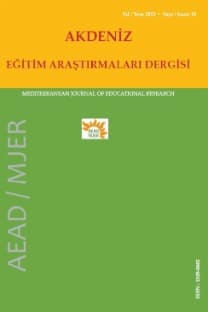The Usage of Cloud and Web Based Mobile Applications by Students at Higher Education: The Two-Step Cluster Analysis
___
Ariffin, S. K., Mohan, T., & Goh, Y. N. (2018). Influence of consumers’ perceived risk on consumers’ online purchase intention. Journal of Research in Interactive Marketing, 12, 309-327.Changchit, C., Cutshall, R., Lonkani, R., Pholwan, K., & Pongwiritthon, R. (2018). Determinants of online shopping influencing Thai consumer’s buying choices. Journal of Internet Commerce, 18, 1-23.
CNET. (2018, March 27). Apps announced at Apple's Chicago education event. Retrieved August 5, 2019, from https://www.cnet.com/pictures/all-the-2018-education-apps-apple-announced/
Çavuş, N., & Uzunboylu, H. (2009). Improving critical thinking skills in mobile learning. Procedia - Social and Behavioral Sciences, 1(1), 434–438.
Flavian, C., & Guinaliu, M. (2006). Consumer trust, perceived security and privacy policy three basic elements of loyalty to a web site. Industrial Management & Data Systems, 106, 601-620.
Gonzalez-Martínez, J., Bote-Lorenzo, M., Eduardo, G., & Rafael, C. (2015). Cloud computing and education: A state-of-the-art survey. Computers & Education, 80, 132-151.
Huseynov, F., & Yıldırım, S. O. (2016). Internet users’ attitudes toward business-to-consumer online shopping: A survey. Information Development, 32, 452-465.
Järveläinen, J. (2007). Online purchase intentions: An empirical testing of a multiple-theory model. Journal of Organizational Computing and Electronic Commerce, 17, 53-74.
Jeno, L. M., Grytnes, J. A., & Vandvik, V. (2017). The effect of a mobile-application tool on biology students' motivation and achievement in species identification: A Self-Determination Theory perspective. Computers & Education, 107, 1-12.
Köse, U., Koç, D., & Yücesoy, S. A. (2013). An augmented reality based mobile software to support learning experiences in computer science courses. Procedia Computer Science, 25, 370–374.
Kutluk, F. A., & Gülmez, M. (2014). A Research about Mobile Learning Perspectives of University Students who have Accounting Lessons. Procedia - Social and Behavioral Sciences, 116, 291–297.
Martin, F., & Ertzberger, J. (2013). Here and now mobile learning: An experimental study on the use of mobile technology. Computers & Education, 68, 76–85.
Meriçelli, M. & Uluyol, Ç. (2016). The Effect of Web Supported and Mobıle Supported Blended Learning Environment on Students Academic Achievement and Motivation. Turkish Studies, 11(9), 879-904.
Moore, G. C., & Benbasat, I. (1991). Development of an Instrument to Measure the Perceptions of Adopting an Information Technology Innovation. Information Systems Research, 2(3), 192–222.
O’Cass, A., & Fenech, T. (2003). Web retailing adoption: Exploring the nature of internet users’ web retailing behavior. Journal of Retailing and Consumer Services, 10, 81-94.
Rogers, E. (2003). Diffusion of Innovations, New York, NY: Free Press.
Rousseeuw, P. J. (1987). Silhouettes: A graphical aid to the interpretation and validation of cluster analysis. Journal of Computational and Applied Mathematics, 20, 53–65.
Sclater, N. (2010). eLearning in the Cloud. International Journal of Virtual and Personal Learning Environments, 1(1), 10-19.
Sırakaya, M., & Sirakaya D. A. (2017). An Examination of Associate Degree Students’ Mobile Learning Attitudes According to Various Variables. Gazi University Journal of Gazi Educational Faculty, 37(3), 1085 – 1114
Smith, H. J., Milberg, S. J., & Burke, S. J. (1996). Information privacy: Measuring individuals’ concerns about organizational practices. MIS Quarterly, 20(2), 167–196.
SPSS Inc. (2001). The SPSS TwoStep cluster component. Retrieved August 10, 2019 from http://www.spss.ch/upload/1122644952_The%20SPSS%20TwoStep%20Cluster%20Component.pdf
Statista. (2019, August 1). Worldwide mobile app revenues in 2014 to 2023 (in billion U.S. dollars). Retrieved August 1, 2019 from https://www.statista.com/statistics/269025/worldwide-mobile-apprevenue-forecast/
- ISSN: 1309-0682
- Yayın Aralığı: 4
- Başlangıç: 2008
- Yayıncı: Tayfun Taşbilek
Mehmet Aydın SAĞLIK, NECDET AYKAÇ
Sınıf Öğretmeni Adaylarının Okul Dışı Öğrenmeye İlişkin Farkındalıklarının Değerlendirilmesi
SEHER YARAR KAPTAN, ADEM BELDAĞ
Öğretmenlerin Hizmet Öncesi Eğitim Deneyimleri: Öğretmen Yetiştirme Üzerine Bir Analiz
Öğretmenlerin Eğitimde İnsansı Robot Teknolojisini Kabul Düzeyleri
NURAY YILDIRIM, SÜLEYMAN NİHAT ŞAD
Özel Yetenekli Öğrencilerin e-Öykü Oluşturma Deneyimlerine Ait Görüşleri
